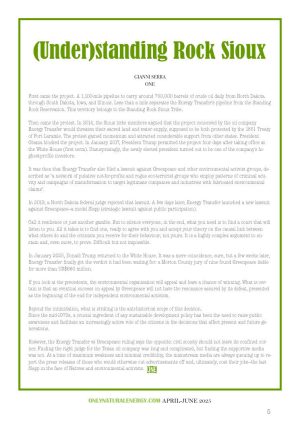 First came the project. A 1,100-mile pipeline to carry around 750,000 barrels of crude oil daily from North Dakota through South Dakota, Iowa, and Illinois. Less than a mile separates the Energy Transfer’s pipeline from the Standing Rock Reservation. This territory belongs to the Standing Rock Sioux Tribe.
First came the project. A 1,100-mile pipeline to carry around 750,000 barrels of crude oil daily from North Dakota through South Dakota, Iowa, and Illinois. Less than a mile separates the Energy Transfer’s pipeline from the Standing Rock Reservation. This territory belongs to the Standing Rock Sioux Tribe.
Then came the protest. In 2014, the Sioux tribe members argued that the project conceived by the oil company Energy Transfer would threaten their sacred land and water supply, supposed to be both protected by the 1851 Treaty of Fort Laramie. The protest gained momentum and attracted considerable support from other states. President Obama blocked the project. In January 2017, President Trump permitted the project four days after taking office at the White House (first term). Unsurprisingly, the newly elected president turned out to be one of the company’s highest-profile investors.
It was then that Energy Transfer also filed a lawsuit against Greenpeace and other environmental activist groups, described as “a network of putative not-for-profits and rogue eco-terrorist groups who employ patterns of criminal activity and campaigns of misinformation to target legitimate companies and industries with fabricated environmental claims”.
In 2019, a North Dakota federal judge rejected that lawsuit. A few days later, Energy Transfer launched a new lawsuit against Greenpeace—a model Slapp (strategic lawsuit against public participation).
Call it resilience or just another gamble. But to silence everyone, in the end, what you need is to find a court that will listen to you. All it takes is to find one, ready to agree with you and accept your theory on the causal link between what others do and the criticism you receive for their behaviour, not yours. It is a highly complex argument to sustain and, even more, to prove. Difficult but not impossible.
In January 2025, Donald Trump returned to the White House. It was a mere coincidence, sure, but a few weeks later, Energy Transfer finally got the verdict it had been waiting for: a Morton County jury of nine found Greenpeace liable for more than US$660 million.
If you look at the precedents, the environmental organisation will appeal and have a chance of winning. What is certain is that an eventual success on appeal by Greenpeace will not have the resonance assured by its defeat, presented as the beginning of the end for independent environmental activism.
Beyond the intimidation, what is striking is the anti-historical scope of this decision.
Since the mid-1970s, a crucial ingredient of any sustainable development policy has been the need to raise public awareness and facilitate an increasingly active role of the citizens in the decisions that affect present and future generations.
However, the Energy Transfer vs Greenpeace ruling says the opposite: civil society should not leave its confined corner.
Finding the right judge for the Texan oil company was long and complicated, but finding the supportive media was not. At a time of maximum weakness and minimal credibility, the mainstream media are always queuing up to report the press releases of those who would otherwise cut advertisements off and, ultimately, cost their jobs—the last Slapp in the face of Natives and environmental activists.
Gianni Serra





